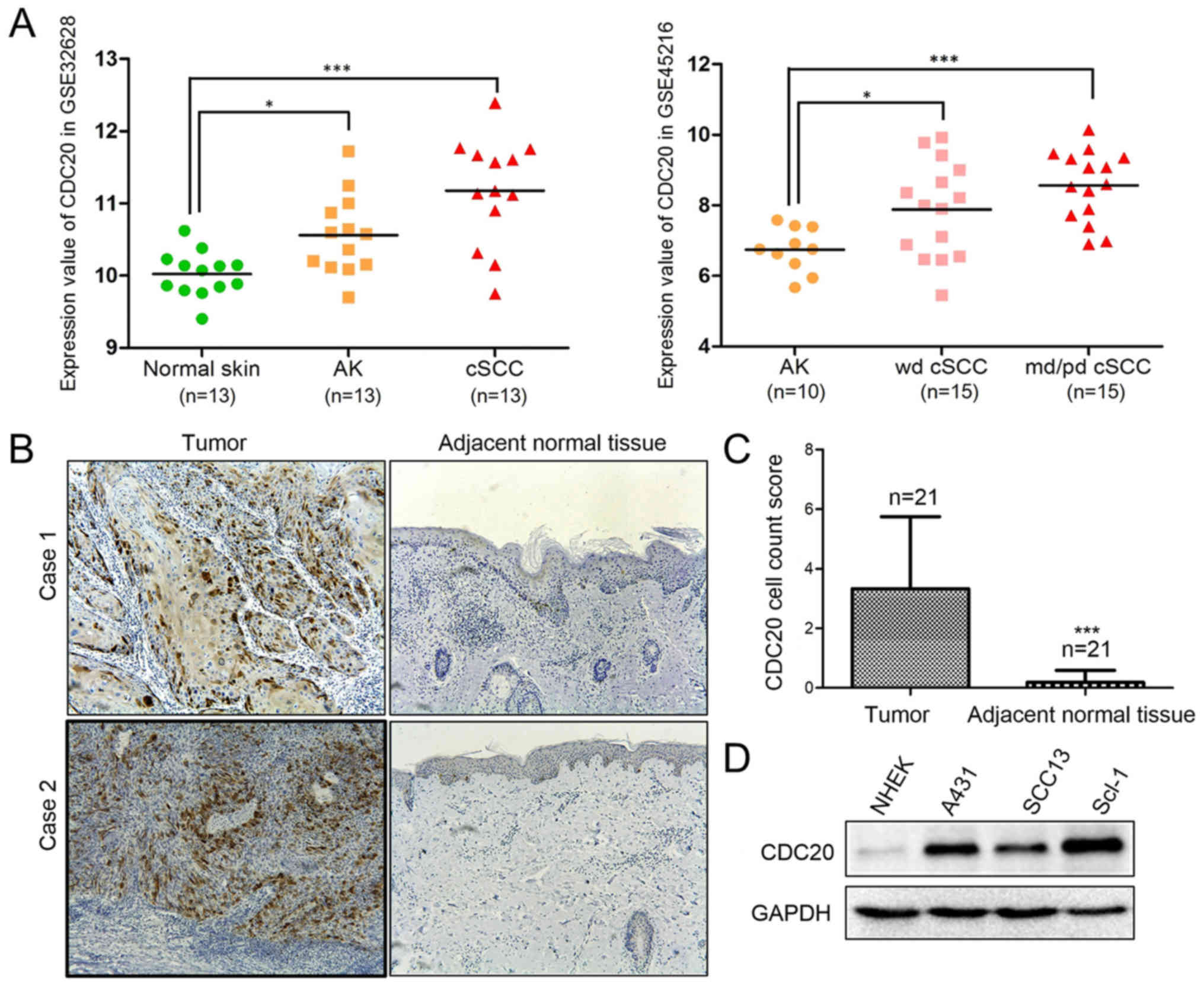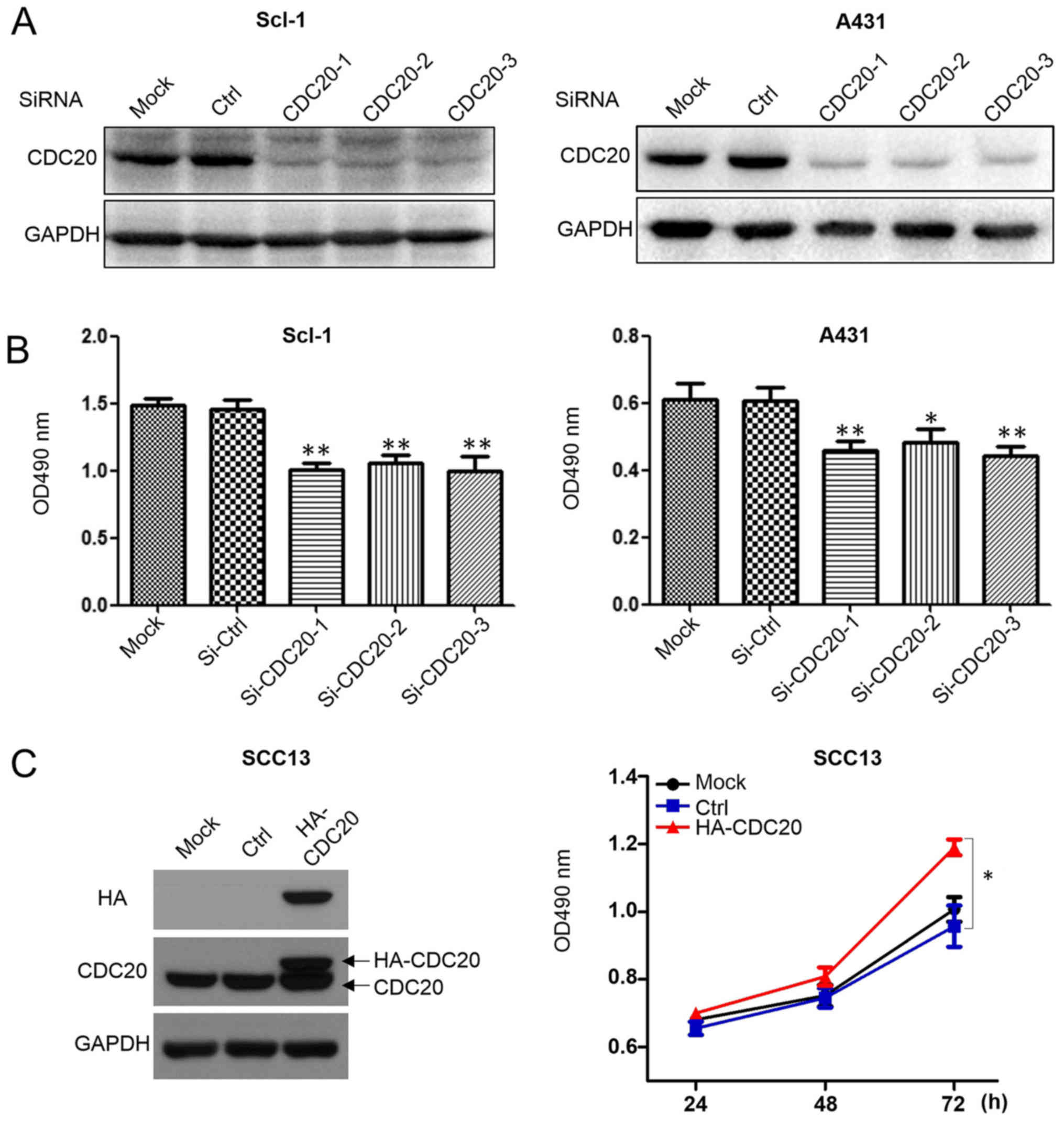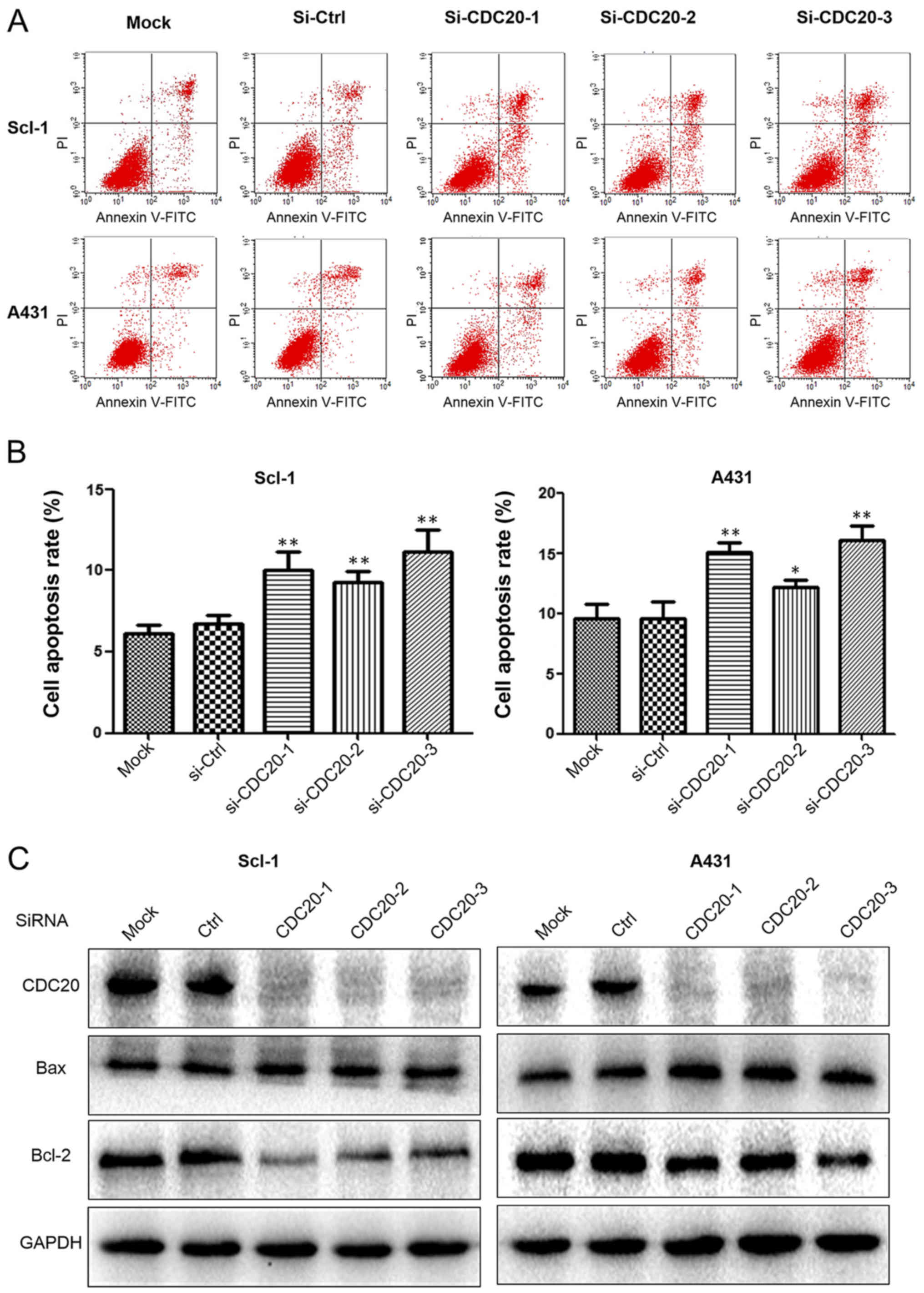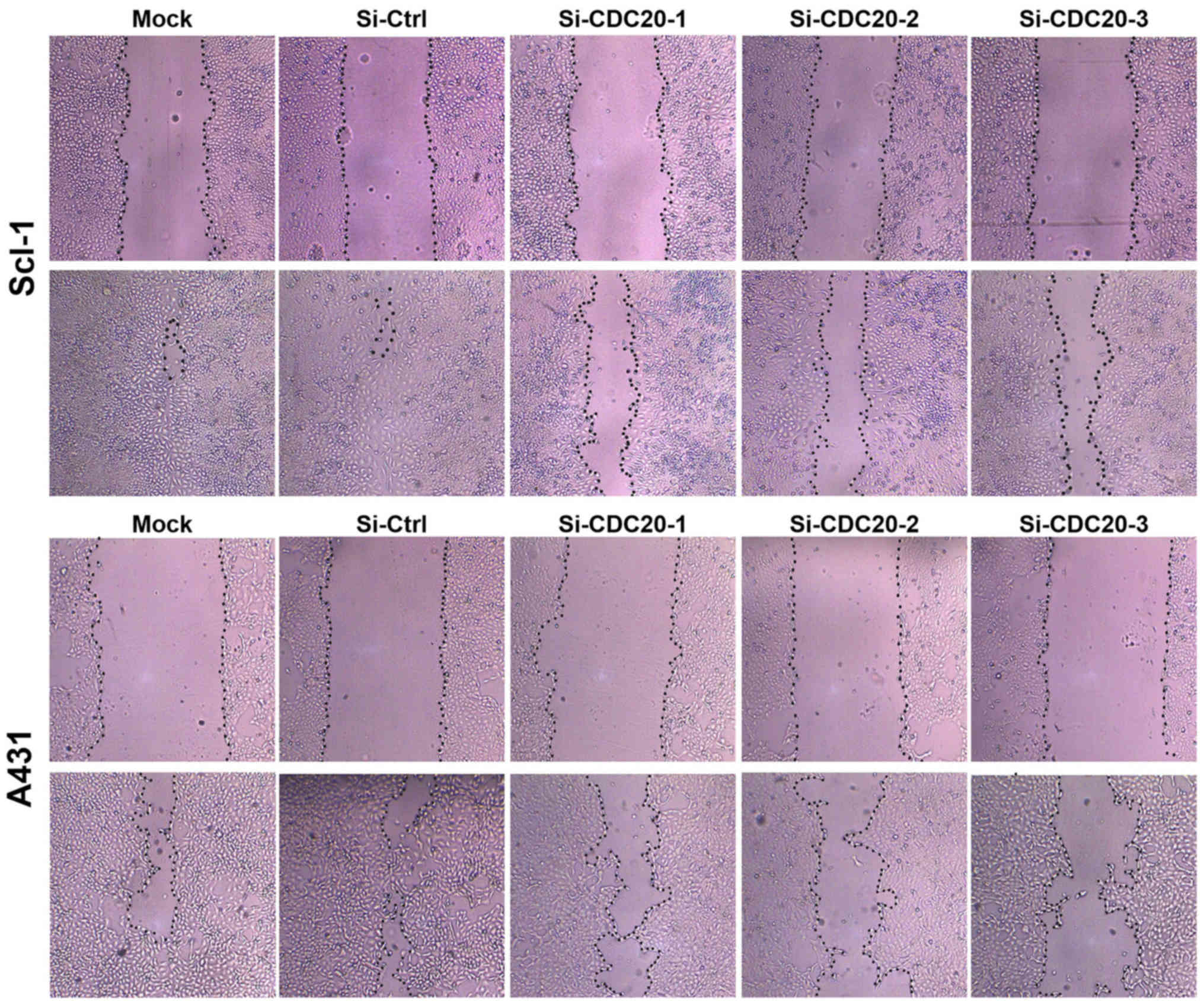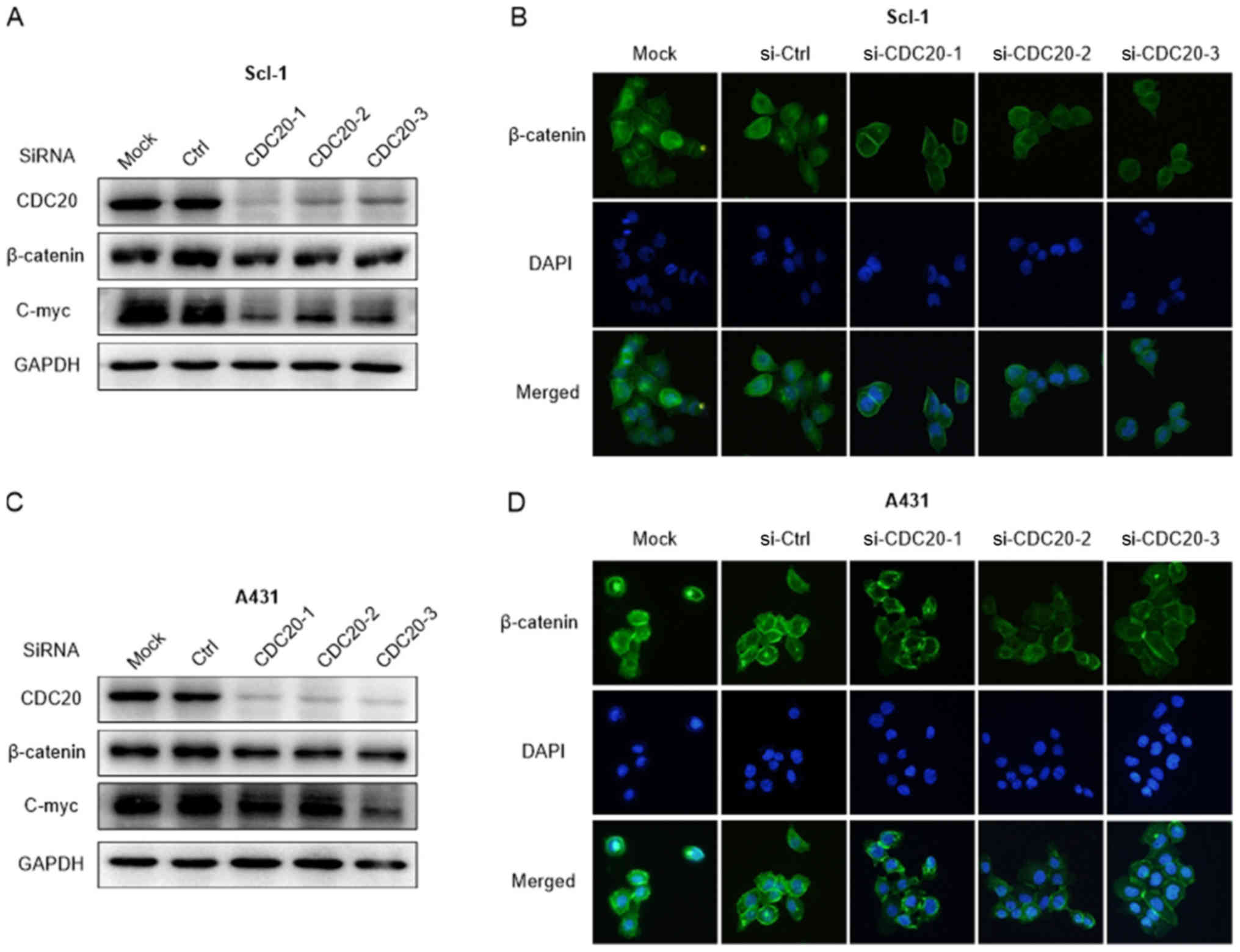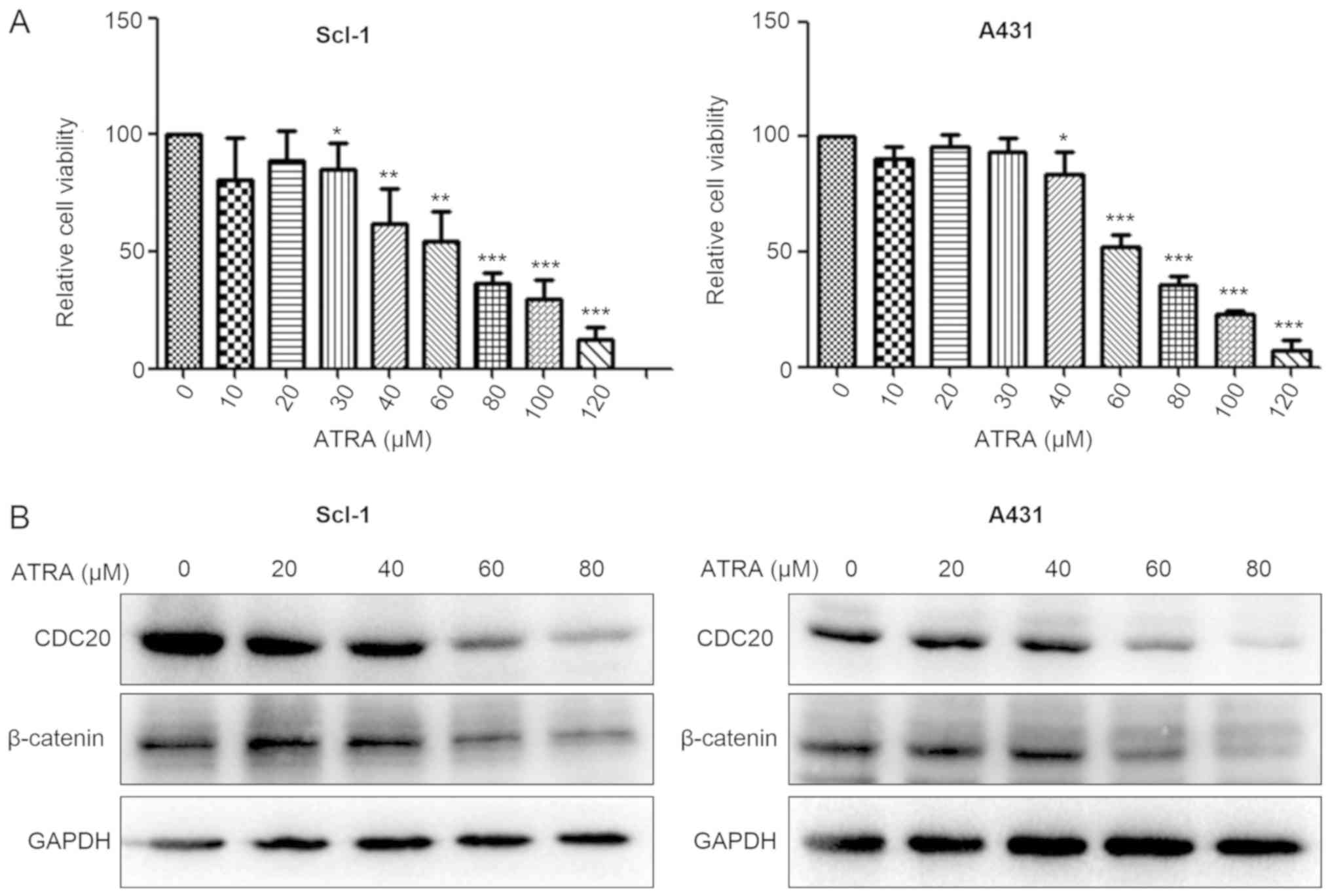Introduction
Cutaneous squamous cell carcinoma (cSCC) is the
second most common form of non-melanoma skin cancer, with an annual
global incidence exceeding 1 million (1). Although the majority of patients with
cSCC have a good prognosis following appropriate therapy, 5-10% of
cases have very poor outcomes, which include local recurrence,
nodal metastasis and disease-specific mortality (2-4).
Given the frequency of its occurrence, cSCC is reported to cause as
many annual mortalities as melanoma in the USA (5). However, there are few reliable
biomarkers to predict the biological behavior and clinical outcome
of cSCC. Therefore, the identification of biomarkers along with a
better understanding of the molecular mechanisms of cSCC is
urgently required for the development of effective treatments for
the disease.
Cell division cycle 20 (CDC20) is a key molecule
that serves an important role in the cell cycle, including as a
spindle assembly checkpoint and as an activator of the
anaphase-promoting complex (APC/C) (6). APC/Ccdc20 serves a crucial role
during the metaphase to anaphase transition, in addition to mitotic
exit, through the destruction of various critical cell cycle
regulators (7). In addition to
regulating the cell cycle, evidence has demonstrated that CDC20
serves an important role in human tumorigenesis and cancer
progression (8). Abnormal
expression of CDC20 may disorder APC/C activation and promote
premature anaphase, which frequently results in mitotic
abnormalities and aneuploidy in the two daughter cells (8). Overexpression of CDC20 has been
observed in a variety of human tumors, including lung cancer,
gastric cancer and breast cancer. Its activity is reported to be
critical for tumor initiation, maintenance and growth (9-17).
However, CDC20 expression and its clinical significance in human
cSCC has not been previously studied, to the best of our
knowledge.
The present study detected the expression of CDC20
in cSCC patient samples at different stages. Its biological
functions were also investigated through a gene knockdown approach
in vitro. The present results suggested that CDC20
expression was positively correlated with the progression of cSCC,
and that the loss of CDC20 suppressed cell growth and migration,
but induced apoptosis and cell cycle arrest in cSCC cells through
inhibition of the wnt/β-catenin signaling pathway. In addition, the
present findings demonstrated that all-trans-retinoic acid (ATRA)
treatment downregulated CDC20 expression in cSCC cells.
Materials and methods
Bioinformatics analyses
The cSCC mRNA expression microarray datasets
GSE32628 and GSE45216 were downloaded from the Gene Expression
Omnibus (GEO) database (https://www.ncbi.nlm.nih.gov/geo) (18,19).
A total of 39 samples [13 cSCC, 13 actinic keratosis (AK) and 13
normal skin] from 13 patients in GSE32628 were included. The
expression values of CDC20 were calculated using GEO2R (https://www.ncbi.nlm.nih.gov/geo/geo2r/). A total of
40 samples (15 well-differentiated cSCC, 15 moderately/poorly
differentiated cSCC and 10 AK) from 40 different patients in
GSE45216 were included. The expression values of CDC20 was
calculated using GEO2R.
Patient samples
Patient tissue blocks were obtained from the
Department of Dermatology at The Second Affiliated Hospital of
Xi'an Jiaotong University (Xi'an, China). These tissues were
obtained from patients at the hospital between April 2014 and March
2017. Written informed consent for tissue procurement was obtained.
Inclusion criteria were as follows: Clinical data and medical
history were well-documented; patients were diagnosed with normal
skin, SCC in situ, AK or cSCC; and patients had not received
any pre-operative treatment. The exclusion criterion was a history
of any other cancer. There was a total of 21 paired cSCC tissues
and adjacent normal skin tissues, and 144 samples of different
pathological differentiation stages (29 well-differentiated cSCC,
25 moderately/poorly differentiated cSCC, 27 SCC in situ, 31
AK and 32 normal skin tissues obtained from cosmetic surgery). The
differentiation stages of all samples were determined by two
experienced pathologists. Among these patients, there were 52 male
and 113 female, their ages ranged from 11 to 92 years, with a
median age of 57.
Immunohistochemistry
The paraffin-embedded human tissue were sectioned
into 4-µm-thick slices and mounted on slides. Following
being de-waxed, rehydrated and blocked with goat serum (reagent A
in the SP-9002 kit; OriGene Technologies, Inc., Beijing, China) at
room temperature for 1 h, slides were incubated with primary
anti-CDC20 antibody (1:100; cat. no. sc-13162; Santa Cruz
Biotechnology, Inc., Dallas, TX, USA) overnight at 4°C.
Subsequently, the sections were incubated with the biotin-labeled
goat anti-mouse IgG working solution (reagent B in the SP-9002 kit;
OriGene Technologies, Inc.) at room temperature for 30 min.
Detection was achieved with diaminobenzidine for 10 sec and
counterstaining with hematoxylin for 30 sec at room temperature,
and routine dehydration, clearing and mounting were performed. The
staining results were evaluated under an optical microscope
(magnification, ×100) by two independent pathologists. Each sample
was given a score by multiplying the stain intensity grade (0, no
staining; 1, low intensity; 2, medium intensity; 3, strong
intensity) by the numerical code for the percentage of positive
cells (≤5%=0; 6-25%=1; 26-50%=2; 51-75%=3; >75%=4). The average
score of five fields was taken as the final score of CDC20
expression for each slide.
Cell lines and cell culture
The human cSCC cell lines A431 and SCL-1 were
purchased from the Cell Bank of the Shanghai Institute of Cell
Biology (Shanghai, China), and SCC13 was provided as a gift from Dr
Yuming Xia (Department of Dermatology, The Second Affiliated
Hospital of Xi'an Jiaotong University). The cells were cultured in
Dulbecco's modified Eagle's medium (DMEM) (HyClone; GE Healthcare
Life Sciencies, Logan, UT, USA) supplemented with 10% fetal bovine
serum (Biological Industries, Kibbutz Beit Haemek, Israel). Primary
keratinocytes were isolated from the foreskin epidermis of a
23-year old man by Hu et al (20). Keratinocytes were cultured in
Keratinocyte Media (ScienCell Research Laboratories, San Diego, CA,
USA). The cells were cultured at 37°C in a humidified incubator
with 5% CO2.
Transient transfection of CDC20 small
interfering (si) RNA and plasmids
The siRNA oligonucleotides were synthesized by
Shanghai GenePharma Co., Ltd. (Shanghai, China), and their
sequences are listed in Table I.
A431 and SCL-1 cells were seeded in 6-well/96-well plates and
transfected with 100 pmol/10 pmol siRNA, respectively, the
following day, according to the recommended procedures for
Lipofectamine® 2000 Transfection Reagent (Invitrogen;
Thermo Fisher Scientific, Inc., Waltham, MA, USA). The CDC20
expression plasmid (HA-CDC20; cat. no. 11594) and the empty control
expression plasmid (pCS2P+; cat. no. 17095), which had the same
backbone as the CDC20 expression construct, were purchased from
Addgene, Inc. (Cambridge, MA, USA). SCC13 cells were seeded in
6-well/96-well plates and transfected with plasmid the following
day. Plasmid DNA was diluted in OptiMEM (Gibco; Thermo Fisher
Scientific, Inc.) and combined with 1 µg/ml polyethylenimine
(PEI) in a 1:3 ratio (DNA:PEI). The PEI/DNA mix was added in a
dropwise manner to the cells, and they were incubated for 12 h. The
DMEM was refreshed and the cells were harvested or counted after 72
h. Cells treated with the transfection reagent only acted as the
mock transfection control.
 | Table ISequences of the siRNAs used in the
present study. |
Table I
Sequences of the siRNAs used in the
present study.
| Name | Sequences |
|---|
| si-CDC20-1 | Sense:
5′-GGAUUGGAGUUCUGGGAAUTT-3′ |
| Antisense:
5′-AUUCCCAGAACUCCAAUCCTT-3′ |
| si-CDC20-2 | Sense:
5′-GCAGAAACGGCUUCGAAAUTT-3′ |
| Antisense:
5′-AUUUCGAAGCCGUUUCUGCTT-3′ |
| si-CDC20-3 | Sense:
5′-GAUGAGACCCUGAGGCUAUTT-3′ |
| Antisense:
5′-AUAGCCUCAGGGUCUCAUCTT-3′ |
| Si-ctrl | Sense:
5′-UUCUUCGAACGUGUCACGUTT-3′ |
| Antisense:
5′-ACGUGACACGUUCGGAGAATT-3′ |
Reverse transcription-quantitative
polymerase chain reaction (RT-qPCR)
RNA samples were isolated using the
TRIzol® reagent (Invitrogen; Thermo Fisher Scientific,
Inc.) and reverse transcribed to cDNA using the PrimeScript RT
reagent kit (Takara Bio, Inc., Otsu, Japan). The reaction
conditions were 37°C for 15 min and 85°C for 5 sec, followed by
rapid cooling to 4°C and storage at -20°C. The CDC20 mRNA levels in
each group were detected using SYBR Premix Ex Taq (Takara Bio,
Inc.) on a StepOnePlus™ Real-Time PCR System (Applied Biosystems;
Thermo Fisher Scientific, Inc.). The cycling conditions were: 95°C
for 30 sec, followed by 40 cycles at 95°C for 5 sec and 60°C for 30
sec. The gene expression levels were calculated using the
2−ΔΔCq method (21) and
each experiment was repeated three times. The primer sequences were
as follows: CDC20 (forward, 5′-GACCACTCCTAGCAAACC TGG-3′ and
reverse, 5′-GGGCGTCTGGCTGTTTTCA-3′) and GAPDH (forward,
5′-ACCACAGTCCATGCCATCAC-3′ and reverse,
5′-TCCACCACCCTGTTGCTGTA-3′).
Western blotting
Total cellular proteins were extracted from the
cultured cells using lysis buffer [50 mM Tris (pH 7.4), 150 mM
NaCl, 1% NP-40, 50 mM NaF, 1 mM EDTA and 10 mM β-glycerol-P]. The
protein concentration was determined using a Bradford assay
(Bio-Rad Laboratories, Inc., Hercules, CA, USA). Subsequently, 40
µg proteins were separated by 10% SDS-PAGE and transferred
to polyvinylidene difluoride membranes. Following blocking with
non-fat dried milk for 2 h at room temperature, the membranes were
incubated overnight with primary antibodies at 4°C and subsequently
incubated with a horseradish peroxidase (HRP)-conjugated secondary
antibody (anti-Rabbit IgG; 1:3,000; cat. no. 7074; Cell Signaling
Technology, Inc.; anti-mouse IgG; 1:3,000; cat. no. 7076; Cell
Signaling Technology, Inc.) for 2 h at room temperature. The
following primary antibodies were used in this study: Anti-CDC20
(1:1,000; cat. no. 14866; Cell Signaling Technology, Inc., Danvers,
MA, USA), anti-cyclin A (1:200; cat. no. sc-271682; Santa Cruz
Biotechnology, Inc.), anti-cyclin B1 antibody (1:1,000; cat. no.
12231; Cell Signaling Technology, Inc.), anti-apoptosis regulator
Bcl-2 (Bcl-2; 1:200; cat. no. sc-492; Santa Cruz Biotechnology,
Inc.), anti-apoptosis regulator BAX (Bax; 1:200; cat. no. sc-6236;
Santa Cruz Biotechnology, Inc.), anti-β-catenin (1:1,000; cat. no.
8480; Cell Signaling Technology, Inc.), anti-c-Myc proto oncogene
protein (c-Myc; 1:1,000; cat. no. 5605; Cell Signaling Technology,
Inc.), anti-GAPDH (1:4,000; cat. no. CW0101; CWBIO, Beijing, China)
and anti-hemagglutinin (HA; 1:1,000; cat. no. H3663; Sigma-Aldrich;
Merck KGaA). Protein bands were visualized using the Immobilon
western chemiluminescent HRP substrate (cat. no. WBKLS0500; EMD
Millipore, Billerica, MA, USA).
MTT assay
Cells were seeded in 96-well plates (A431,
5×103 cells/well; Scl-1, 3×103 cells/well;
and SCC13, 5×103 cells/well) in quintuplicate and
transfected with the negative control siRNA, CDC20 siRNA, HA-CDC20
plasmid or empty control plasmid the following day. Relative cell
numbers were measured 24, 48 or 72 h subsequently by incubating
cells with 20 µl 0.5 mg/ml MTT at 37°C for 4 h. Following
complete removal of the medium, 150 µl dimethyl sulfoxide
was administrated to dissolve the formazan. The relative absorbance
at a wavelength of 490 nm was measured with a microplate reader
(model 680; Bio-Rad Laboratories, Inc.). A total of three
independent experiments were performed. Meanwhile, cells were
seeded in 96-well plates and treated with different concentrations
of ATRA (cat. no. R2625; Sigma-Aldrich; Merck KGaA; 1, 10, 20, 40,
60, 80, 100 and 120 µM) the following day. Relative cell
numbers were measured 48 h after ATRA treatment using the
aforementioned method. A total of three independent experiments
were performed.
Cell cycle analysis
The siRNA-transfected cells were harvested 48 h
after transfection. For the analysis, cells were harvested, fixed
with ice-cold 70% ethanol overnight, and stored overnight at -4°C.
The cells were stained with the Cell Cycle Detection kit (Nanjing
KeyGen Biotech Co., Ltd., Nanjing, China), and incubated for 30 min
in the dark at room temperature, according to the manufacturer's
protocol. The cells were analyzed using flow cytometry
(FACSCalibur; BD Biosciences, San Diego, CA, USA). ModFit LT™ V3.3
(Verity Software House, Inc., Topsham, ME, USA) was used to analyze
the results. A total of three independent experiments were
performed.
Cell apoptosis analysis
The siRNA-transfected cells were harvested 48 h
after transfection. For the analysis, the cells were stained with
the Annexin V-fluorescein isothiocyanate/propidium iodide (PI)
Apoptosis Detection kit (KeyGEN Biotech, Nanjing, China), following
the manufacturer's instructions. Stained cells were analyzed by
flow cytometry (FACSCalibur; BD Biosciences). FlowJo 10 (FlowJo
LLC, Ashland, OR, USA) was used to analyze the results. A total of
three independent experiments were performed.
Wound-healing assay
Cells were seeded into six-well plates (A431,
5×105 cells/well; Scl-1, 3×105 cells/well)
and transfected with the negative control siRNA or CDC20 siRNA the
following day. A total of 48 h after transfection, wounds were
created in the cell monolayer using a 200 µl pipette tip.
Cell debris was removed by washing once with PBS, followed by the
addition of fresh DMEM containing 1% fetal bovine serum. The
healing process was followed for the next 72 h.
Immunofluorescent staining
Cells were grown on glass coverslips. Following
fixing with 4% paraformaldehyde at room temperature for 30 min,
permeabilization with 0.5% Triton X-100 and blocking with 5% bovine
serum albumin (Thermo Fisher Scientific., Inc.) for 1 h at room
temperature, the cells were incubated with primary antibodies
against β-catenin (1:100, cat. no. 8480; Cell Signaling Technology,
Inc.) at 4°C overnight. Subsequently, the cells were incubated with
the appropriate goat anti-rabbit IgG2 secondary antibody at room
temperature for 1 h in the dark. The nuclei were counterstained
with DAPI for 10 min at room temperature and imaged with a confocal
laser-scanning microscope (magnification, ×200) (Nikon Corporation,
Tokyo, Japan).
Statistical analysis
Data are presented as the mean ± standard deviation.
Statistical analyses were performed using GraphPad Prism 5.0
(GraphPad Software, Inc., La Jolla, CA, USA). The Student's t-test
was used for comparisons between two groups, and one-way analysis
of variance with Dunnett's or Bonferroni's post hoc test was
applied for experiments with more than two groups. P<0.05 was
considered to indicate a statistically significant difference.
Results
CDC20 is significantly upregulated in
cSCC tumor tissues and cSCC cell lines
The analysis results from GEO2R for GSE32628 and
GSE45216 are presented in Fig. 1A.
In GSE32628, the mRNA expression values of CDC20 were 10.02±0.31 in
normal skin tissues (n=13), 10.56±0.55 in AK tissues (n=13) and
11.17±0.74 in cSCC tissues (n=13). The CDC20 mRNA expression level
was significantly higher in AK and cSCC tumor tissues compared with
paired normal skin tissues (Fig.
1A). In GSE45216, the mRNA expression values of CDC20 were
6.74±0.63 in the AK group (n=10), 7.89±1.35 in the
well-differentiated cSCC group (n=15) and 8.56±0.99 in the
moderately/poorly differentiated cSCC group (n=15). CDC20
expression was significantly increased in well-differentiated cSCC
and moderately/poorly differentiated cSCC compared with AK
(Fig. 1A).
Along with the results of the bioinformatics
analysis, the immunohistochemical staining in 21 paired cSCC and
corresponding normal tissues confirmed the elevated CDC20
expression in cancerous tissues (Fig.
1B and C). In addition, compared with the primary human
epidermal keratinocytes, CDC20 was upregulated in cSCC cell lines
A431, SCL-1 and SCC13 at the mRNA (data not shown) and protein
level (Fig. 1D). Furthermore, the
expression of CDC20 protein was detected in 144 samples from
patients with cSCC at different stages, including normal skin
tissues (n=32), precancerous actinic keratosis lesions (n=31), cSCC
in situ (n=27), well-differentiated cSCC (n=29) and
moderately/poorly differentiated cSCC (n=25). Subsequent
semiquantitative analysis of the immunohistochemistry results
demonstrated that CDC20 expression was significantly higher in cSCC
in situ, well-differentiated cSCC, and moderately/poorly
differentiated cSCC compared with normal skin, and was associated
with disease progression (Fig. 2).
The findings indicated that CDC20 may have an oncogenic role in
cSCC progression.
 | Figure 2Expression of CDC20 is associated
with cSCC progression. (A) Normal skin (n=32) (magnification,
×100). (B) Actinic keratosis (n=31) (magnification, ×100). (C) cSCC
in situ (Bowen's disease; n=27) (magnification, ×100). (D)
Well-differentiated cSCC (n=29) (magnification, ×100). (E)
Moderately or poorly differentiated cSCC (n=25) (magnification,
×100). (F) Semiquantitative analysis of CDC20 expression in the
different tissues. CDC20, cell division cycle 20; cSCC, cutaneous
squamous cell carcinoma; wd, well-differentiated; md/pd, moderately
or poorly differentiated. *P<0.05,
***P<0.001 vs. normal skin. |
CDC20 silencing inhibits the
proliferation of cSCC cells and leads to cell cycle arrest
Compared with normal human epidermal keratinocytes,
all the cSCC cell lines has increased CDC20 protein expression
levels (Fig. 1D); however, among
the three cSCC cell lines, SCC13 had the lowest basal level of
CDC20. To test the potential oncogenic effects of CDC20, CDC20 was
downregulated in Scl-1 and A431 cells, and overexpressed in SCC13.
CDC20 silencing suppressed the growth of A431 and Scl-1 cells, as
determined by the MTT assay (Fig. 3A
and B). Transfection of HA-tagged CDC20 led to an increased
total level of CDC20 protein and promoted the growth of SCC13 cells
(Fig. 3C). Cell cycle analysis
demonstrated that CDC20 depletion led to cells accumulating in the
G2/M phase (Fig. 3D and E) and an
increased expression level of cyclin B1 and cyclin A (Fig. 3F), suggesting arrest in early
mitosis.
CDC20 silencing promotes apoptosis and
inhibits migration in cSCC in vitro
Annexin V/PI staining was performed to detect
apoptosis. Non-transfected or control siRNA-transfected cells
exhibited a lower apoptosis rate of 11-12% in A431 and 6-7% in
SCL-1 cells compared with the increased apoptosis rate of 12-16% in
A431 and 9-12% in Scl-1 cells following CDC20 silencing (Fig. 4A and B). The increased apoptosis
was associated with increased expression of the apoptosis-promoting
gene Bax and decreased expression of the apoptosis-suppressing gene
Bcl-2 (Fig. 4C). These results
demonstrated that CDC20 was involved in protecting cSCC cells
against apoptosis and that depletion of CDC20 induced apoptosis. In
addition, to analyze whether CDC20 was able to inhibit the motility
of cSCC cells, wound healing assays were performed. The results
demonstrated that silencing of CDC20 decreased cell migration in
A431 and Scl-1 cells (Fig. 5).
Loss of CDC20 suppresses the
Wnt/β-catenin signaling pathway
To understand the molecular mechanisms of the
oncogenic effects of CDC20, the Wnt/β-catenin signaling pathway,
one of the principal signaling pathways involved in the regulation
of cell growth, survival and migration, was analyzed. The present
results indicated that CDC20 silencing led to a reduced expression
level of β-catenin and c-Myc (Fig. 6A
and B). In line with this, the immunofluorescence results
indicated CDC20 that silencing led to decreased fluorescence and
less distribution of β-catenin in the nucleus (Fig. 6C and D), which indicated that the
translocation of β-catenin into the nucleus was also inhibited by
CDC20 knockdown. These results confirmed that CDC20 contributes to
the growth of cSCC cells by activating the Wnt/β-catenin signaling
pathway.
ATRA treatment downregulates CDC20 and
β-catenin expression in cSCC cells
To determine the suppressive effects of ATRA on cSCC
cells, the MTT assay was conducted. The results demonstrated that
ATRA decreased the viability of A431 and SCL-1 cells in a
concentration-dependent manner (Fig.
7A). To examine whether the CDC20/β-catenin pathway was
involved in ATRA-induced growth inhibition, western blot analysis
was used to detect CDC20 and β-catenin expression in cSCC cells
following ATRA treatment for 48 h. The results demonstrated that
ATRA treatment reduced the CDC20 and β-catenin protein expression
in A431 and Scl-1 cells (Fig.
7B).
Discussion
In recent years, the overexpression of CDC20 has
been documented in a wide range of malignancies. In a number of
tumor types, its expression has been reported to correlate with a
poor clinical outcome, providing evidence for its role in
carcinogenesis and tumor progression (10-11,13).
However, the role of CDC20 in primary cSCC has not been previously
reported, to the best of our knowledge. In the present study, it
was demonstrated that CDC20 is overexpressed in cSCC tissues in
addition to cSCC cell lines, and its expression is associated with
tumor progression. Knockdown of CDC20 suppressed cell growth and
migration, and promoted apoptosis and cell cycle arrest in
cSCC.
Similar to what has been observed in other tumor
types (9), CDC20 expression was
low in normal intact skin and was significantly increased in tumor
cells in cSCC, suggesting that CDC20 may work as a biomarker for
cSCC. Furthermore, the elevated expression of CDC20 in AK and cSCC
in situ, and its association with histological
classification, provide evidence that the induction of CDC20
expression is an early event in cSCC development and may serve a
role in the progression of in situ cSCC to the invasive
stage. However, there were no follow-up data for the patients in
the present study, thus it was not possible to draw any conclusion
about the prognostic value of CDC20.
CDC20 was overexpressed in SCC13 cells since this
was the cell line with the lowest basal level of CDC20. When SCC13
was first established in 1981, it was identified that its colony
formation efficiency was low and in a nude mouse model it tended to
form large differentiating cysts with an organized structure, which
is a pathological sign of good differentiation (22,23).
Therefore SCC13 was considered to be a well-differentiated cSCC
cell line in the present study. The immunohistochemistry results
demonstrated that CDC20 was not only elevated in cancerous tissues,
but was also associated with tumor differentiation and progression.
The low basal protein level of CDC20 may, on the other hand,
support the well-differentiated classification of SCC13. Therefore,
the overexpression experiment was conducted to see whether CDC20
was able to induce malignancy, and the present results demonstrated
that overexpression of CDC20 slightly increased the growth of SCC13
cells.
CDC20 is known to regulate the separation of
chromosomes by inducing ubiquitination and the degradation of cell
cycle regulators, including cyclin A and cyclin B1 in a D-box
dependent manner at the beginning of metaphase, loss of CDC20
results in the accumulation of cyclin B1 and cyclin A (15). While the degradation of cyclin B
induces exit from mitosis (telophase and cytokinesis) (16), non-degradable cyclin B1 may arrest
human cells in a metaphase-like state (17,24).
CDC20 mutation/depletion blocks cell division and stops cell cycle
progression toward anaphase and chromosome segregation (25). Consistent with this report, it was
observed in the present study that CDC20 knockdown inhibited the
proliferation of cSCC cells and led to G2/M cell cycle arrest.
CDC20 depletion induces the expression of cyclin A and cyclin B1
(24,26), and exogenous expression of CDC20
slightly increased the growth of SCC13 cells in the present study.
Similarly, a recent study confirmed that the overexpression of
CDC20 promoted cell growth, inhibited apoptosis, and enhanced cell
migration and invasion in osteosarcoma cells (27). In addition, it was reported that
CDC20 may control mitotic progression by targeting a number of
novel substrates, including ubiquitin interaction motif containing
1, PHD finger protein 8 and BRCA1 associated RING domain 1
(28,29). These findings support the
hypothesis that CDC20 serves a crucial role in cell cycle
regulation.
In addition to G2/M phase arrest, the present data
demonstrated that the inhibition of CDC20 activity led to the
induction of apoptosis. CDC20 depletion increased the expression of
Bax and reduced the expression of Bcl-2. Similar regulation of
apoptosis by CDC20 has been observed in other studies. For example,
in multiple tumor-derived cell lines, Bcl-2 like 11 accumulation
upon CDC20 knockdown contributes to apoptosis induction and
chemoradiation sensitization (30). Another study suggested that CDC20
governs apoptosis by mediating the degradation of the
anti-apoptotic protein induced myeloid leukemia cell
differentiation protein Mcl-(31).
Furthermore, it was demonstrated that CDC20 regulated the migratory
ability of cSCC cells. This finding is consistent with the results
from a previous study, demonstrating that CDC20 expression was
further increased in matched metastatic liver tissues compared with
primary colorectal cancer tissues (13).
Wnt signaling through β-catenin has long been
recognized to be crucial for skin epidermal development and
homeostasis (32). A number of
studies have confirmed that it is essential for cSCC initiation and
progression, and for maintaining the cancer stem cell niche
(33). Based on the primary
hypothesis that targeting CDC20 may improve the aggressive
properties of cSCC, the present study sought to investigate whether
this process was associated with suppression of the canonical
Wnt/β-catenin pathway. Wnt/β-catenin is a well-known pathway that
is involved in the progression of cSCC. Recently, Zimmerli et
al (33) reported that the
Wnt/β-catenin pathway controlled the initiation and progression of
human papillomavirus-driven cSCC. Although the effect of
stimulation of Wnt/β-catenin on the cellular behavior of cSCC was
not assessed in the present study, β-catenin and c-Myc, which are
classically important components involved in the Wnt/β-catenin
signaling pathway, were tested following silencing of CDC20. The
present results demonstrated that CDC20 silencing led to a
significantly decreased protein expression level of β-catenin and
c-Myc, and inhibited the translocation of β-catenin into the
nucleus, suggesting that CDC20 contributes to the development of
cSCC through the Wnt/β-catenin signaling pathway. However, there
were a number of limitations to the signaling pathway analysis.
First, the role of other proteins involved in the Wnt/β-catenin
pathway, including adenomatous polyposis coli protein, axin and
zinc finger protein SNAI1 were not tested in the present study.
Second, it was not possible to ascertain whether β-catenin is the
substrate of the APC/C-CDC20 complex.
Retinoids have long been considered for use in the
treatment and prevention of cancer (34,35).
The present finding that ATRA was able to inhibit cSCC cell growth
was consistent with the results reported by Zhang et al
(36). The fact that ATRA was able
to downregulate the expression of CDC20 indicates that CDC20 may
work as a potential therapeutic target in cSCC. It was noted that
the cell killing effect of ATRA was marked at ~60 µM, a
relatively high concentration. However, the majority of retinoids
are available for topical use, which means that they may be able to
work directly and specifically on skin cancer lesions. Severe side
effects of topical retinoids are very rare despite their high
concentrations (for example, 0.1% adapalene gel) (37). Thus, for patients with a localized
AK or cSCC in situ, topical retinoids may be beneficial.
Meanwhile, discovering and validating small molecule inhibitors
specifically targeting CDC20 remains critical for future studies.
It is noteworthy that a recent study demonstrated that the systemic
use of CDC20 siRNA was able to inhibit solid growths of
subcutaneously injected melanoma and spontaneous growth of
intravenously injected melanoma cells on the mouse lung (38). Therefore, CDC20 is a promising
target for the treatment of human cancer.
In conclusion, the present results demonstrated that
CDC20 serves a carcinogenic role in human cSCC, and may therefore
serve as a novel target for early prevention, diagnosis and
treatment.
Funding
The present study was supported by the National
Natural Science Foundation of China (grant no. 81372912), Funds of
Northwest Hospital of Xi'an Jiaotong University [grant no.
RC(GG)201602], and the Fundamental Research Funds for the Central
Universities (grant no. PY3A0241001016).
Availability of data and materials
The datasets used and/or analyzed during the current
study are available from the corresponding author on reasonable
request.
Authors' contributions
ZWC and SMG designed and performed the experiments,
XYZ and QYL participated in the collection of clinical samples and
data analysis, GLH contributed to the isolation of the primary
keratinocytes, and CGL interpreted the data and critically revised
the manuscript. All authors have read and approved the final
version of the manuscript.
Ethics approval and consent to
participate
The use of human tissues was approved by the Ethics
Committee of the Second Affiliated Hospital of Xi'an Jiao Tong
University and patient consent was obtained.
Consent for publication
Not applicable.
Competing interests
The authors declare that they have no competing
interests.
Acknowledgments
The authors would like to thank Dr Bin Zheng and Dr
Yi Lv for technical assistance.
References
|
1
|
Lomas A, Leonardi-Bee J and Bath-Hextall
F: A systematic review of worldwide incidence of nonmelanoma skin
cancer. Br J Dermatol. 166:1069–1080. 2012. View Article : Google Scholar : PubMed/NCBI
|
|
2
|
Stratigos A, Garbe C, Lebbe C, Malvehy J,
del Marmol V, Pehamberger H, Peris K, Becker JC, Zalaudek I, Saiag
P, et al: European Dermatology Forum (EDF); European Association of
Dermato-Oncology (EADO); European Organization for Research and
Treatment of Cancer (EORTC): Diagnosis and treatment of invasive
squamous cell carcinoma of the skin: European consensus-based
interdisciplinary guideline. Eur J Cancer. 51:1989–2007. 2015.
View Article : Google Scholar : PubMed/NCBI
|
|
3
|
Levine DE, Karia PS and Schmults CD:
Outcomes of patients with multiple cutaneous squamous cells
carcinomas: A 10-year single institution cohort study. JAMA
Dermatol. 151:1220–1225. 2015. View Article : Google Scholar : PubMed/NCBI
|
|
4
|
Schmults CD, Karia PS, Carter JB, Han J
and Qureshi AA: Factors predictive of recurrence and death from
cutaneous squamous cell carcinoma: A 10-year, single-institution
cohort study. JAMA Dermatol. 149:541–547. 2013. View Article : Google Scholar : PubMed/NCBI
|
|
5
|
Karia PS, Han J and Schmults CD: Cutaneous
squamous cell carcinoma: Estimated incidence of disease, nodal
metastasis, and deaths from disease in the United States, 2012. J
Am Acad Dermatol. 68:957–966. 2013. View Article : Google Scholar : PubMed/NCBI
|
|
6
|
Chang L, Zhang Z, Yang J, McLaughlin SH
and Barford D: Atomic structure of the APC/C and its mechanism of
protein ubiquitination. Nature. 522:450–454. 2015. View Article : Google Scholar : PubMed/NCBI
|
|
7
|
Primorac I and Musacchio A: Panta rhei:
The APC/C at steady state. J Cell Biol. 201:177–189. 2013.
View Article : Google Scholar : PubMed/NCBI
|
|
8
|
Bharadwaj R and Yu H: The spindle
checkpoint, aneuploidy, and cancer. Oncogene. 23:2016–2027. 2004.
View Article : Google Scholar : PubMed/NCBI
|
|
9
|
Gayyed MF, El-Maqsoud NM, Tawfiek ER, El
Gelany SA and Rahman MF: A comprehensive analysis of CDC20
overexpression in common malignant tumors from multiple organs: Its
correlation with tumor grade and stage. Tumour Biol. 37:749–762.
2016. View Article : Google Scholar
|
|
10
|
Kato T, Daigo Y, Aragaki M, Ishikawa K,
Sato M and Kaji M: Overexpression of CDC20 predicts poor prognosis
in primary non-small cell lung cancer patients. J Surg Oncol.
106:423–430. 2012. View Article : Google Scholar : PubMed/NCBI
|
|
11
|
Ding ZY, Wu HR, Zhang JM, Huang GR and Ji
DD: Expression characteristics of CDC20 in gastric cancer and its
correlation with poor prognosis. Int J Clin Exp Pathol. 7:722–727.
2014.PubMed/NCBI
|
|
12
|
Karra H, Repo H, Ahonen I, Löyttyniemi E,
Pitkänen R, Lintunen M, Kuopio T, Söderström M and Kronqvist P:
Cdc20 and securin overexpression predict short-term breast cancer
survival. Br J Cancer. 110:2905–2913. 2014. View Article : Google Scholar : PubMed/NCBI
|
|
13
|
Wu WJ, Hu KS, Wang DS, Zeng ZL, Zhang DS,
Chen DL, Bai L and Xu RH: CDC20 overexpression predicts a poor
prognosis for patients with colorectal cancer. J Transl Med.
11:1422013. View Article : Google Scholar : PubMed/NCBI
|
|
14
|
Li J, Gao JZ, Du JL, Huang ZX and Wei LX:
Increased CDC20 expression is associated with development and
progression of hepatocellular carcinoma. Int J Oncol. 45:1547–1555.
2014. View Article : Google Scholar : PubMed/NCBI
|
|
15
|
Yam CH, Fung TK and Poon RY: Cyclin A in
cell cycle control and cancer. Cell Mol Life Sci. 59:1317–1326.
2002. View Article : Google Scholar : PubMed/NCBI
|
|
16
|
Rieder CL: Mitosis in vertebrates: The
G2/M and M/A transitions and their associated checkpoints.
Chromosome Res. 19:291–306. 2011. View Article : Google Scholar : PubMed/NCBI
|
|
17
|
Wolf F, Wandke C, Isenberg N and Geley S:
Dose-dependent effects of stable cyclin B1 on progression through
mitosis in human cells. EMBO J. 25:2802–2813. 2006. View Article : Google Scholar : PubMed/NCBI
|
|
18
|
Hameetman L, Commandeur S, Bavinck JN,
Wisgerhof HC, de Gruijl FR, Willemze R, Mullenders L, Tensen CP and
Vrieling H: Molecular profiling of cutaneous squamous cell
carcinomas and actinic keratoses from organ transplant recipients.
BMC Cancer. 13:582013. View Article : Google Scholar : PubMed/NCBI
|
|
19
|
Lambert SR, Mladkova N, Gulati A, Hamoudi
R, Purdie K, Cerio R, Leigh I, Proby C and Harwood CA: Key
differences identified between actinic keratosis and cutaneous
squamous cell carcinoma by transcriptome profiling. Br J Cancer.
110:520–529. 2014. View Article : Google Scholar :
|
|
20
|
Hu G, Liang L, Liu Y, Liu J, Tan X, Xu M,
Peng L, Zhai S, Li Q, Chu Z, et al: TWEAK/Fn14 Interaction Confers
Aggressive Properties to Cutaneous Squamous Cell Carcinoma. J
Invest Dermatol. November 8–2018.Epub ahead of print.
|
|
21
|
Livak KJ and Schmittgen TD: Livak KJ and
Schmittgen TD: Analysis of relative gene expression data using
real-time quantitative PCR and the 2-ΔΔCT method. Methods.
25:402–408. 2001. View Article : Google Scholar
|
|
22
|
Rheinwald JG and Beckett MA: Tumorigenic
keratinocyte lines requiring anchorage and fibroblast support
cultured from human squamous cell carcinomas. Cancer Res.
41:1657–1663. 1981.PubMed/NCBI
|
|
23
|
Que SKT, Zwald FO and Schmults CD:
Cutaneous squamous cell carcinoma: Incidence, risk factors,
diagnosis, and staging. J Am Acad Dermatol. 78:237–247. 2018.
View Article : Google Scholar : PubMed/NCBI
|
|
24
|
Izawa D and Pines J: How APC/C-Cdc20
changes its substrate specificity in mitosis. Nat Cell Biol.
13:223–233. 2011. View
Article : Google Scholar : PubMed/NCBI
|
|
25
|
Wang L, Zhang J, Wan L, Zhou X, Wang Z and
Wei W: Targeting Cdc20 as a novel cancer therapeutic strategy.
Pharmacol Ther. 151:141–151. 2015. View Article : Google Scholar : PubMed/NCBI
|
|
26
|
Geley S, Kramer E, Gieffers C, Gannon J,
Peters JM and Hunt T: Anaphase-promoting
complex/cyclosome-dependent proteolysis of human cyclin A starts at
the beginning of mitosis and is not subject to the spindle assembly
checkpoint. J Cell Biol. 153:137–148. 2001. View Article : Google Scholar : PubMed/NCBI
|
|
27
|
Shang G, Ma X and Lv G: Cell division
cycle 20 promotes cell proliferation and invasion and inhibits
apoptosis in osteosarcoma cells. Cell Cycle. 17:43–52. 2018.
View Article : Google Scholar :
|
|
28
|
Lim HJ, Dimova NV, Tan MK, Sigoillot FD,
King RW and Shi Y: The G2/M regulator histone demethylase PHF8 is
targeted for degradation by the anaphase-promoting complex
containing CDC20. Mol Cell Biol. 33:4166–4180. 2013. View Article : Google Scholar : PubMed/NCBI
|
|
29
|
Song L and Rape M: Regulated degradation
of spindle assembly factors by the anaphase-promoting complex. Mol
Cell. 38:369–382. 2010. View Article : Google Scholar : PubMed/NCBI
|
|
30
|
Wan L, Tan M, Yang J, Inuzuka H, Dai X, Wu
T, Liu J, Shaik S, Chen G, Deng J, et al: APC(Cdc20) suppresses
apoptosis through targeting Bim for ubiquitination and destruction.
Dev Cell. 29:377–391. 2014. View Article : Google Scholar : PubMed/NCBI
|
|
31
|
Harley ME, Allan LA, Sanderson HS and
Clarke PR: Phosphorylation of Mcl-1 by CDK1-cyclin B1 initiates its
Cdc20-dependent destruction during mitotic arrest. EMBO J.
29:2407–2420. 2010. View Article : Google Scholar : PubMed/NCBI
|
|
32
|
Ku AT, Miao Q and Nguyen H: Monitoring
Wnt/β-Catenin Signaling in Skin. Methods Mol Biol. 1481:127–140.
2016. View Article : Google Scholar
|
|
33
|
Zimmerli D, Cecconi V, Valenta T, Hausmann
G, Cantù C, Restivo G, Hafner J, Basler K and van den Broek M: WNT
ligands control initiation and progression of human
papillomavirus-driven squamous cell carcinoma. Oncogene.
37:3753–3762. 2018. View Article : Google Scholar : PubMed/NCBI
|
|
34
|
Blomberg M, He SY, Harwood C, Arron ST,
Demehri S and Green A: Research gaps in the management and
prevention of cutaneous squamous cell carcinoma in organ transplant
recipients. Br J Dermatol. 177:1225–1233. 2017. View Article : Google Scholar : PubMed/NCBI
|
|
35
|
Que SKT, Zwald FO and Schmults CD:
Cutaneous squamous cell carcinoma: Management of advanced and
high-stage tumors. J Am Acad Dermatol. 78:249–261. 2018. View Article : Google Scholar : PubMed/NCBI
|
|
36
|
Zhang ML, Tao Y, Zhou WQ, Ma PC, Cao YP,
He CD, Wei J and Li LJ: All-trans retinoic acid induces cell-cycle
arrest in human cutaneous squamous carcinoma cells by inhibiting
the mitogen-activated protein kinase-activated protein 1 pathway.
Clin Exp Dermatol. 39:354–360. 2014. View Article : Google Scholar : PubMed/NCBI
|
|
37
|
Riahi RR, Bush AE and Cohen PR: Topical
Retinoids: Therapeutic Mechanisms in the Treatment of Photodamaged
Skin. Am J Clin Dermatol. 17:265–276. 2016. View Article : Google Scholar : PubMed/NCBI
|
|
38
|
Mukherjee A, Bhattacharyya J, Sagar MV and
Chaudhuri A: Liposomally encapsulated CDC20 siRNA inhibits both
solid melanoma tumor growth and spontaneous growth of intravenously
injected melanoma cells on mouse lung. Drug Deliv Transl Res.
3:224–234. 2013. View Article : Google Scholar : PubMed/NCBI
|















